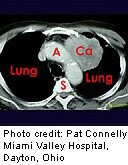Reduction in false-positive result rate, but reduction in sensitivity also observed
TUESDAY, Feb. 10, 2015 (HealthDay News) — Use of the American College of Radiology Lung Imaging Reporting and Data System (Lung-RADS) classification system for low-dose computed tomography (LDCT) can reduce the false-positive result rate but also decreases sensitivity, according to a study published online Feb. 10 in the Annals of Internal Medicine.
Paul F. Pinsky, Ph.D., from the National Cancer Institute in Bethesda, Md., and colleagues conducted a retrospective assessment to apply the Lung-RADS criteria to the National Lung Screening Trial (NLST). Participants, aged 55 to 74 years, with at least a 30-pack-year smoking history, and who were current smokers or had quit in the past 15 years, were randomized to the LDCT group of the NSLT. They underwent three annual LDCT lung cancer screenings.
Of the 26,722 participants, 26,455 received a baseline screen and 48,671 screenings were performed after baseline. The researchers found that the false-positive result rate for Lung-RADS was 12.8 percent at baseline, compared with 26.6 percent for the NLST; after baseline, the false-positive result rates were 5.3 and 21.8 percent, respectively. Baseline sensitivity was 84.9 and 93.5 percent for Lung-RADS and NLST, respectively; after baseline, the sensitivities were 78.6 and 93.8 percent, respectively.
“Lung-RADs may substantially reduce the false-positive result rate; however, sensitivity is also decreased,” the authors write. “The effect of using Lung-RADs criteria in clinical practice must be carefully studied.”
Full Text (subscription or payment may be required)
Copyright © 2015 HealthDay. All rights reserved.








